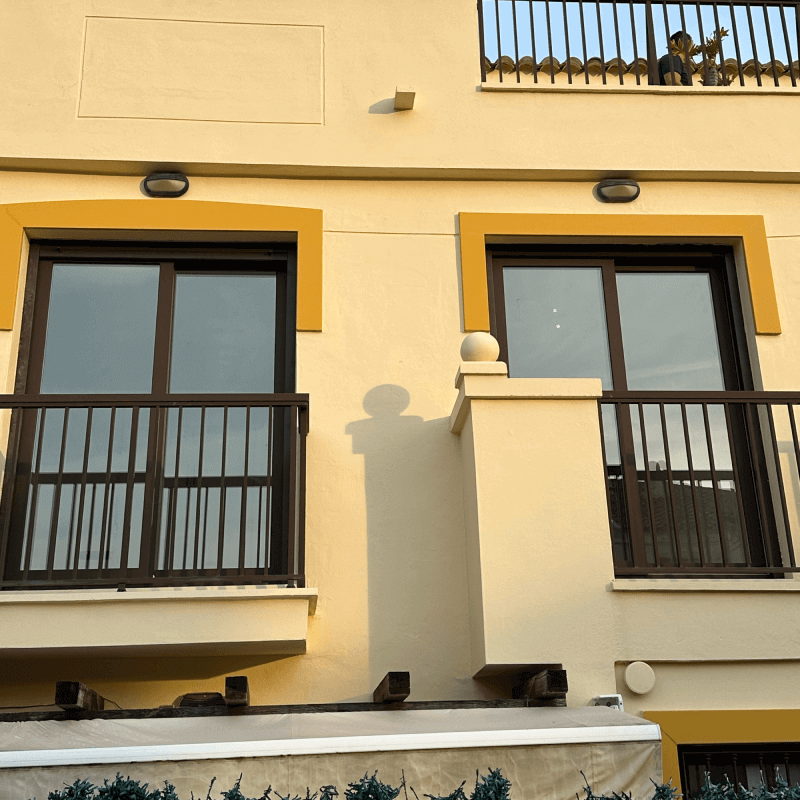Window Energy Performance Certificates: What's Important to Know When Buying in Spain
· María Fernández · Standards and permits · 10 min read
When choosing windows, you’ll see a variety of markings: CE, AENOR, Passivhaus, and class A++. Each represents a specific characteristic that impacts comfort and energy bills. We’ll explore which certifications are truly important, what those mysterious numbers in the registration document mean, and how to avoid overpaying for features unnecessary in the Spanish climate.
Mandatory CE marking—the bare minimum
The CE marking on windows is like a driver’s license. Without it, windows can’t be sold in Europe. But the CE marking itself only indicates that the window meets minimum safety requirements and has passed basic tests.
Next to the CE marking should be a four-digit number—the code of the organization that tested the windows. For example, CE 0099 indicates testing by the German ift Rosenheim institute, and CE 0432 by the Spanish AENOR. If there’s no number or it can’t be found on Google, you’re looking at a counterfeit.
The CE marking is accompanied by a declaration of conformity with the test results. It specifies the actual window performance characteristics, such as thermal transmittance, sound insulation, and wind resistance. The seller is obliged to provide this declaration upon request. If they refuse or “lose” it, find another supplier.
Important: the CE marking tests the entire window assembly, not its individual components. The profile may be excellent, and the insulating glass unit energy efficient, but if they are assembled incorrectly, the window will not pass certification. Therefore, buying a profile from one source, the insulating glass unit from another, and having it assembled by a third contractor is a bad idea.
Energy Label – Like a Refrigerator
Since 2021, windows in Spain have been receiving energy labels similar to those found on refrigerators. Classes from A++ to G indicate how energy efficient the window is in a given climate.
The label is divided into two parts: a winter rating and a summer rating. A window can have a class A winter efficiency rating (good heat retention) and a class C summer efficiency rating (poor heat insulation). Both indicators are important in Madrid, while summer efficiency is more important in Malaga and winter efficiency is more important in mountainous areas.
Class A means the window will save at least 25% energy compared to a standard class D window. Class A+ saves 35%, and A++ saves over 50%. The price difference between classes C and A is 15-20%, but pays for itself in 3-4 years on electricity bills.
The label also shows the thermal transmittance (U-value) in W/m²K. For class A in central Spain, this is a maximum of 1.8 W/m²K, while for A+, it is a maximum of 1.4 W/m²K. The lower the number, the better the insulation.
Spanish AENOR Standard – Quality Mark
AENOR (Spanish Standardization Association) issues voluntary quality certificates. The AENOR N mark means that windows are regularly inspected by independent inspectors and comply with Spanish UNE standards.
The AENOR certificate verifies not only the window itself but also the production process. Inspectors visit the factory unannounced, take random samples, and check the equipment and worker qualifications. This guarantees consistent quality across the entire batch, not just a test sample.
For the Spanish climate, the AENOR UV resistance certificate is especially important. The sun in Andalusia can turn white plastic yellow in five years if the formulation doesn’t contain the right additives. AENOR tests windows in a chamber simulating 10 years of sun exposure.
Windows with the AENOR certificate are 10-15% more expensive, but this is insurance against problems. If an AENOR-certified window is found to be defective, the association will assist with the claim and compensation. With uncertified Chinese windows, you’ll be left to deal with the problem alone.
Classification by Technical Characteristics
Window technical data sheets indicate classes based on three parameters: air permeability, water resistance, and wind resistance. This is written, for example, as “Class 4, 9A, C5.”
Air Permeability (Classes 1-4, where 4 is the highest air tightness). Class 4 means that less than 3 m³ of air per hour per m² passes through a closed window in strong winds. For Spain, Class 3 is sufficient; Class 4 is only needed in very windy areas or high-rise buildings.
Water Tightness (Classes 1A-9A and E750-E1200). This indicates the rain pressure at which the window remains airtight. Class 5A is sufficient for most of Spain, but for Galicia or the Basque Country with their Atlantic storms, 7A or higher is better.
Wind load (classes C1-C5 for deflection and B1-B5 for pressure). Class C3 withstands winds of 120 km/h without deformation—sufficient for most regions. On the coast, especially on upper floors, C4 or C5 are required.
These classes are interrelated. There’s no point in installing a window with a Class 4 air permeability rating if its water resistance rating is Class 2A—air will also pass through cracks that allow water to pass through.
Acoustic Certificates — Silence Costs Money
Window sound insulation is measured in decibels (dB). A basic window with a single double-glazed unit reduces noise by 28-30 dB. This is sufficient for a quiet street, but insufficient for a city center.
The acoustic performance certificate shows the Rw index, which represents noise reduction under laboratory conditions, and the Ctr index, which adjusts for urban noise (low frequencies from traffic). Actual sound insulation = Rw + Ctr. For example, a window with an Rw of 35 dB and a Ctr of -2 dB provides 33 dB of effective protection from street noise.
A bedroom next to a busy road requires windows with a minimum insulation rating of 35 dB, preferably 40 dB. This is achieved with asymmetrical double-glazed units (glass of different thicknesses), laminated glass, or increased spacing between the panes. The price difference is €50-80 per m², but the difference in comfort is significant.
The Spanish DB-HR standard divides buildings into categories based on required sound insulation. If your home is in an “acoustically polluted zone” (daytime noise levels above 65 dB), the developer is required to install windows with increased sound insulation. You can check the noise levels in your area on the municipal noise maps.
Safety Certificates – Protecting Family and Property
Burglar-resistant windows are classified according to standard EN 1627 from RC1 to RC6. For private homes, classes RC2 and RC3 are relevant.
RC2 — Basic protection against forced entry using improvised means (screwdriver, pliers). The window must be able to withstand at least 3 minutes of opening. Includes reinforced hardware, mushroom-shaped pins, and a handle with a button or key. Additional price: €150-200 per window.
RC3 — Protection against a prepared break-in with a crowbar and professional tools. Minimum 5 minutes of resistance. Requires P4A vandal-resistant glass (8-10 mm laminated glass), a reinforced frame, and special hardware. Costs €400-500 more than a standard window.
For first-floor and easily accessible second-floor windows, a minimum RC2 rating is recommended. Insurance companies often offer a 5-10% discount on home insurance for the installation of certified burglar-resistant windows.
Safety glass is rated according to EN 12600: Class 1B1 withstands the impact of a soft body (human) from a height of 1.2 m. Mandatory for French windows, glass doors, and glazing lower than 80 cm from the floor. Failure to comply is not only dangerous but can also lead to insurance issues in the event of injury.
Passivhaus — German precision for a passive house
The Passivhaus certificate is the most stringent energy efficiency standard. Windows must have a U-value of no more than 0.8 W/m²K for the entire structure, including the frame. This requires triple-glazing, a super-insulated frame, and perfect installation.
In Spain, Passivhaus windows are overkill for most projects. They are 70-100% more expensive than standard energy-efficient windows, heavier (due to hardware issues), and transmit less light (three panes of glass instead of two). The payback period in the Spanish climate is over 20 years.
Exceptions include mountainous regions with cold winters and passive house projects, where windows are part of a comprehensive system. In a passive house, the right windows work in conjunction with heat-recovery ventilation, super-insulated walls, and proper orientation.
Important: Some sellers claim “Passivhaus profiles” or “Passivhaus double-glazed windows.” This is just marketing. A Passivhaus certificate is issued only for the complete window after testing the specific combination of frame, glass, and hardware.
Warranty Certificates – Investment Protection
The standard window warranty in Spain is 2 years by law. However, high-quality manufacturers offer extended warranties with certificates:
- 10 years on the profile against fading and deformation
- 5 years on the double-glazed window against leaks
- 2-5 years on the hardware, subject to annual maintenance
- 5 years on the aluminum paintwork
The warranty certificate must clearly state what is and is not covered. Typical exclusions include damage due to improper use, lack of maintenance, and installation by an unauthorized installer. Keep all documents and receipts—without them, the warranty is void.
The installation certificate from an authorized installer is a separate and important document. It confirms proper installation and preserves the manufacturer’s warranty. Saving €200-€300 on “in-house” installation can result in the loss of a €3,000 warranty on windows.
Eco-Certificates — Caring for the Planet
Eco-certificates are becoming important when selling real estate and applying for “green” mortgages with reduced rates.
Cradle to Cradle evaluates the entire life cycle of a window, from production to disposal. PVC windows with this certification are made from recycled plastic and can be recycled again. The price premium is 5-10%, and the resale value of the home is up to 3%.
FSC or PEFC for wooden windows — a guarantee of sustainable forest management. Wood from certified forests, where every tree cut down is replanted. Important for environmentally conscious buyers.
An Environmental Product Declaration (EPD) provides comprehensive information about a window’s carbon footprint. Some manufacturers offset CO2 emissions during production, making their windows “carbon neutral.” While this is primarily a marketing ploy, the trend is growing.
How to read a window’s technical data sheet
The technical data sheet is the most important document for a window. It should include:
- The window’s thermal transmittance (Uw) and the individual glass (Ug) and frame (Uf) values
- Solar factor (g) — the percentage of solar energy passing through the glass
- Light transmittance (LT) — the percentage of visible light
- Air, water, and wind resistance classes
- Sound insulation in dB
- Dimensions of the test sample (characteristics vary with size)
Practical tips for choosing
Don’t chase maximum performance. An A++-class triple-glazed window in Valencia is like a fur coat in Africa. Paying a 40% premium for a 10% improvement in performance is not economically justified.
Ask for certificates before payment. If the seller promises to “deliver them later” or shows a photo on their phone, look for another seller. Originals or certified copies of all certificates must be available immediately.
Save all documents. They will be needed for the warranty, insurance, apartment sale, and energy efficiency subsidies. Make copies and store them separately from the originals.
Use certificates when selling your home. Documented energy-efficient windows increase the energy rating of a home and its value by 2-5%.
Proper certificates aren’t bureaucracy; they’re a guarantee that the windows will perform as promised. In Spain, where windows last 30-40 years, saving on certified products will result in overpayments on electricity bills and early window replacement.





